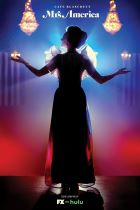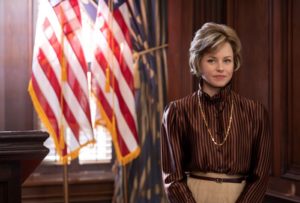 Mrs. America is an FX original limited series created by Dahvi Waller and tells the story of the movement known as the Equal Rights Amendment (ERA) in the 1970s with an unexpected opposition from conservative activist Phyllis Schlafly (Cate Blanchett). The series depicts the major ERA players with a star-studded cast in Gloria Steinem (Rose Byrne), Shirley Chisholm (Uzo Aduba), Jill Ruckelshaus (Elizabeth Banks), Betty Friedan (Tracey Ullman), Bella Abzug (Margo Martindale), Brenda Feigen-Fasteau (Ari Graynor), and many others.
Mrs. America is an FX original limited series created by Dahvi Waller and tells the story of the movement known as the Equal Rights Amendment (ERA) in the 1970s with an unexpected opposition from conservative activist Phyllis Schlafly (Cate Blanchett). The series depicts the major ERA players with a star-studded cast in Gloria Steinem (Rose Byrne), Shirley Chisholm (Uzo Aduba), Jill Ruckelshaus (Elizabeth Banks), Betty Friedan (Tracey Ullman), Bella Abzug (Margo Martindale), Brenda Feigen-Fasteau (Ari Graynor), and many others.
The series is broken into nine parts, each emphasizing the importance of a specific character. The editing in the show featured three editors in Robert Komatsu, Emily Greene, and Todd Downing. Komatsu edited “Phyllis” (Ep.1), “Betty” (Ep.4), and “Bella” (Ep. 7). Greene took on “Gloria” (Ep.2), “Phyllis & Fred & Brenda & Marc” (Ep.5), and “Reagan” (Ep.9). While, Komatsu and Greene bookended the series, Downing handled “Shirley” (Ep.3), “Jill” (Ep.6), and “Houston” (Ep.8); the only episode not titled after a person, but displaying Alice Macray’s (Sarah Paulson) character development while she attends the National Women’s Conference in Houston.

The “Houston” episode is about the 1977 National Women’s Conference in Houston, which was the largest women’s gathering since the 1848 Women’s Right Convention in Seneca Falls, estimating nearly 20,000 plus in attendance. Alice, Rosemary (Melanie Lynskey), and Pamela (Kayli Carter) travel to the conference and enter enemy territory labeled as the Stop ERA (Antis) group with a vast majority of attendees being Pro ERA supporters. The episode follows Alice’s trip through that and having an epiphany while she’s there. Alice is highlighted in almost every scene within that episode.
Alice becomes distraught by all the extreme opposition, so she sits down at the bar, while this lady hands her a pill to calm her nerves as she had never taken anything before. Downing enlightened, “She’s completely tripped out and was wandering through the women’s convention going into a primal scream therapy tent full of lesbians, ending up in a gay lounge, people talking about abortion, just everything that is horrible to her character. When we were editing it, we wanted to make it off, but not too trippy, she’s not on acid. We didn’t want to distract from her story and her performance, we didn’t go over the top with the editing. It was more subtly making the sounds wrong, jump cuts that weren’t necessary, jumping from room to room, and we played with a bit where she was.”
“The best thing was to make it stick with the character, while showing that she’s completely out of her mind on a pill. Our composer put all these train sounds in along with his violins and whatnot. It’s so great to really get into one person’s head and identify with them through the whole thing. It makes it so much more intense.”

“When Alice is on the phone with her mom and the pills start kicking in. It’s just a two-and a-half-minute shot of her talking to her mom about a recipe. It’s incredible because her performance is so great and we started doing weird things with the sounds to insinuate that something was going wrong in her head. The scene was long, but it tells the audience that something went wrong because all of a sudden, we’ve just broken out of our pattern of normal dialogue into this really long phone call about something really innate. When we have an actor like that, we have the liberty to do these really long takes,” the editor elaborated.
“Episode eight was hard in the way that it was just so different. The trip took quite a long time to cut in trying to find the right balance of how druggy or real it’s supposed to feel. In the beginning, I went way overboard with it, we really toned it back.”
Besides episode eight, each episode was titled after a specific person for their prominence. “That was a concept from the very beginning. One of the writers told me they wanted each episode to feel a little bit different, have a little bit different style. The film grain, the look of it changed through the 70’s as well to match the progression of film. What they were really trying to do each year and have each character as a distinct chapter. It is a history lesson as well, but hopefully an enjoyable one. It’s nice to choose one episode to watch and learn,” Downing expanded.

For a 1970s period piece, archival footage was also embedded within each episode. The editor said, “We had an archival producer that gave us a lot of archives in every episode. I come from a documentary background and the last thing I cut was a feature documentary that was all made from archival. It felt very natural. We tried not to overuse it. We always wanted to make it have a story point, it had to be there for a purpose, it is well integrated into the storyline.”

Editor Todd Downing has previously been nominated for the Hollywood Post Alliance and the American Cinema Editors (ACE) for the editing on Russian Doll and a three-time nominee for the BAFTA Awards for his work on Panorama and North Korea: Life Inside the Secret State.
Mrs. America has brought a renewed awareness and forefront for the Equal Rights Amendment (ERA). Only 35 states ratified the ERA by 1979 as a minimum of 38 was required to pass. The latest states to ratify the ERA were Nevada (2017), Illinois (2018), and Virginia became the 38th state in January of 2020 after the expiration of the previously set deadlines. Subsequently four decades later, the Equal Rights Amendment is indefinite and the law-making decisions still proceeding.





